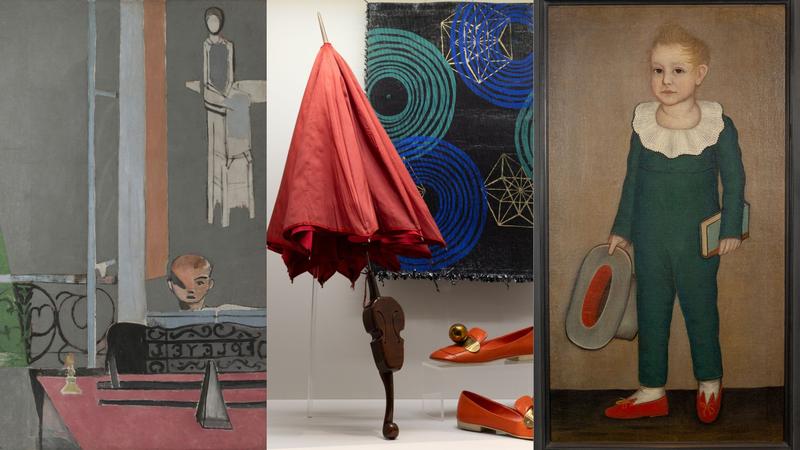
( Courtesy of the MoMA, the Museum at FIT, and the American Folk Art Museum )
Day Four: Portrait of Frederick A. Gale by Ammi Phillips
" I'm Jason Bush and I'm the Becky and Bob Alexander Director and CEO at the American Folk Art Museum in New York. I'm really excited to talk about “Portrait of Frederick A. Gale” by the artist Ammi Phillips. This particular work made me swoon the first time I saw it. Few comparable works exist of this quality scale and, I think, sheer emotional power. So this was a portrait made about 1815, and the painting portrays Frederick Gale as a young boy of about five years of age. In this portrait of Frederick, in particular, the differences in color and texture and shape, they coexist to form a complex interplay like a melody and countermelody. And the arresting background of the portrait, the boy's soft face, the pop of red from inside of a hat, and the strong colors of the figure all of that's presented together for a sense of push and pull and tension and resolution, which leads to this harmonious viewing experience that moves your eye around the painting. It draws you in and it keeps you there. This portrait of Frederick Gale is one of the few works that has been on view in all three iterations of our ongoing exhibition at the American Folk Art Museum, Somewhere to Roost, which is on view at AFAM through May 25th."
Day Three: Fragment from Homage to New York by Jean Tinguely
" My name is Michelle Kuo and I am the Chief Curator at Large and Publisher of the Museum of Modern Art. This is a sculpture, but it's not quite a sculpture. It is actually a fragment of a performance from March 18th, 1960, and that evening, the Swiss artist Jean Tingeuly, let loose a large scale contraption in the Sculpture Garden, right here at the Museum of Modern Art. And it was this sprawling, almost Rube Goldberg-like machine with different kinds of gears and wheels and levers. And the whole thing almost looks like a bicycle turned on its side, except it's a bicycle that would be impossible to ride. He called it Homage to New York, and it really was this humorous love letter to New York and the idea that- I think we still face this today when we walk down the streets of New York. On the one hand, we live in such a high tech, fast-paced environment. At the same time, clearly we're still in a kind of mechanical infrastructure. The street is still the street. It's, you know, we're pounding the pavement. It's a real world that we see a lot of contradictions in and Tingeuly even 50, 60 years ago, saw those same contradictions, I think, in the city here."
Day Two: Red Umbrella by Unknown
" My name is Colleen Hill and I'm Senior Curator of Costume at the Museum at FIT. I'm talking about an umbrella from the late 1950s, and it's made from bright red silk taffeta. It has a long handle, and at the end of that handle is a beautiful, polished wood violin that is also a music box. And there is a turn key that allows you to play music as you walk or carry the umbrella and, uh, plays the Blue Danube, which was quite fun. The bright red silk taffeta of this umbrella is really eye catching. So it's really quite fantastic to see something that is functional and also very beautiful. So I love to think about this umbrella as being, actually a little bit cheeky, and really kind of an expression of who this woman was. Probably a music lover, probably someone who wanted to stand out a little bit, , in this time before we started to see fashion as such an extreme form of self-expression. I love to think about this umbrella being a sort of Singing in the Rain moment. So if you're either shielding yourself from the heat, or if you're using the umbrella to deter rain, it's cheerful. It's beautiful. And so it in itself is a- has a sort of poetry to it."
Day One: The Piano Lesson by Henri Matisse
"My name is Glenn Lowry and I'm the director of the Museum of Modern Art. I chose Henri Matisse's The Piano Lesson, because it's one of my favorite paintings in the museum. It's a work of art that I come back to almost every day, but certainly every week, because it's so captivating, mesmerizing, intense, depicts a young man front of a piano, learning his lesson, his mother on a chair behind him looking sternly at him and in front of him, a metronome. And you can almost hear the tick and tick and tick of the metronome beating out its rhythm. And then you look at his head, of this young man, and you see that metronome inscribed on it, and you realize the pressure this child must have been under to learn his piano lesson. Then you start to explore the painting and you realize how complicated the space is. It's hard to tell where the foreground and the background begin and end, where the exterior with this bright swath of green that cuts through what must be the window starts and where the window itself ends so that when you look at this picture, there's an intensity of emotion. It's just astounding when you think about what's embedded in this work of art."
